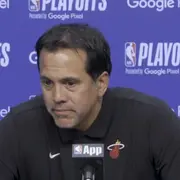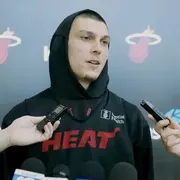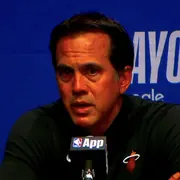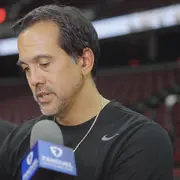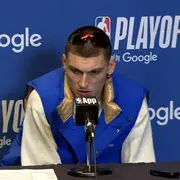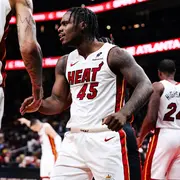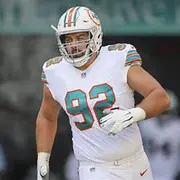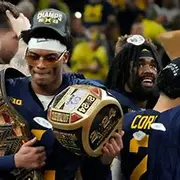The Battle of Florida. One of, if not the most exciting, new-age playoff rivalries in hockey.
For the fourth time in the past five years, the Florida Panthers and Tampa Bay Lightning will meet in the postseason, and for the second straight season, it will be in the first round.
The winner of the previous three Lightning-Panthers playoff series went on to have successful, long summers, with the victor advancing to the Stanley Cup Final each time (TB: 2021, 2022; FLA: 2024).
Game 1 is set to take place at 8:30 p.m. EST from Amalie Arena in Tampa, FL.
Here’s a few things to watch for in this highly anticipated first round matchup.
Ekblad to Miss Start of Series
Aaron Ekblad will have to sit out the first two games of the series as he serves the remainder of a 20-game suspension for violating the terms of the NHL/NHLPA Performance Enhancing Substances Program.
Ekblad is eligible to return to action for Game 3, which is Florida’s playoff home opener. When he does draw into the lineup, he will reunite on the Panthers’ top defense pair with Gustav Forsling.
“That’ll be the toughest two games, of course,” Ekblad said earlier this month. “I’m just going to try and keep myself in as best shape as I can so that once Game 3 rolls around, it’s easy for me to come back in.
“And it’s not the first time that I’ve stepped into the playoffs cold, after injuries even, so I’m confident that I’ll be fine coming into it, but those two games would be very tough to watch, for sure.”
The Panthers were able to get by down the stretch despite missing arguably their second best defenseman for a quarter of the season.
With Ekblad out, Florida was able to get a few different looks on how its defense pairings could line up when they can ice a full strengthened blueline.
Seth Jones and Niko Mikkola are expected to round out the top-four, while Dmitry Kulikov and Nate Schmidt should be in the five-six hole.
New Faces in the Sunshine State
While a bulk of the current Lightning and Panthers players have seen one another before in the postseason, both teams will have some new names hit the ice for their first — playoff edition — Battle of Florida.
On the west coast side of the state, forward Jake Guentzel is by far the most notable newcomer to the rivalry.
A free agent signing last summer, Guentzel has already proved to be a successful acquisition for Lightning GM Julien BriseBois, scoring 41 goals (second most on team) and 80 points (41-39-80) in as many games.
J.J. Moser is another Lightning skater who will get his first taste of playoff hockey with the Bolts. The 24-year-old Swiss defenseman joined Tampa in the offseason in the deal that sent two-time Stanley Cup champion Mikhail Sergachev to the Utah Hockey Club.
The Lightning also brought back a few familiar faces from their Cup teams; Ryan McDonagh and Yanni Gourde weren’t with the team that lost last season to the Panthers, but they are more than well vetted in the Sunshine State rivalry.
Shifting over to the team in Sunrise, the Panthers have their own set of players ready to get their share of Cats playoff hockey.
After being acquired via trade on March 3 from the Chicago Blackhawks, five-time All-Star defenseman Seth Jones had to assume more of a role than was initially expected from him after the Panthers saw their blue line weakened with injuries and the sudden Ekblad suspension. Jones will need to eat a ton of minutes — including both power play and penalty kill time — in the first round, with Ekblad missing the first two games of the series.
Former Boston Bruins captain and Stanley Cup champion Brad Marchand is another new Panther to watch in this series. An agitating player to match up against thanks to his physical and aggressive — yet highly skilled — playstyle, Marchand is the perfect player to throw into the Battle of Florida.
Rookie standout Mackie Samoskevich is another notable player that wasn’t there when the Panthers slayed the dragon to finally defeat the Lightning last season. Samoskevich, 22, scored 15 goals and 31 points (15-16-31) in 72 games this season. In his first year with Florida, he’s already cemented himself as a top-nine forward and power play option.
Return of Tkachuk?
Last time Matthew Tkachuk played in a game was Feb. 20 in the 4 Nations Face-Off final, where he didn’t see much ice-time after sustaining a lower-body injury in the tournament.
The injury kept the Panthers’ star forward sidelined for the last 25 games of the regular season.
Tkachuk only rejoined the team’s practice sessions last week, but he’s been wearing a normal contact jersey and is appearing on his usual lines.
As of Tuesday morning — prior to the team’s morning skate — Panthers head coach Paul Maurice hasn’t said if Tkachuk will play in Game 1 — but the signs are pointing to him being close to ready.
“He’s got to get through the morning skate tomorrow,” Maurice said after Monday’s practice. “If he gets through that morning skate, everyone gives a thumbs up, then he’ll go.”
If Tkachuk is a go for the series opener, he’ll slot right back in on the second line next to Sam Bennett and Mackie Samoskevich.
In 52 games this season, Tkachuk was scoring at a point-per-game rate with 22 goals and 57 points (22-35-57), finishing third on the team in scoring despite missing 30 games.
Not So Under the Radar Players to Watch
Everybody knows the firepower both teams have up and down the lineup.
Kucherov, Point, Hedman, Vasilevsky… Barkov, Tkachuk, Reinhart, Bobrovsky. Keeping it simple, these are two of the most stacked rosters in the league; we’ll be here awhile if we dive deep into every star.
Instead, here’s two gamechangers — one for each team — that have proven themselves as legit top-line players in the NHL, but may fall down the pecking order due to their respective team’s rosters.
Tampa Bay — Brandon Hagel
Lightning forward Brandon Hagel may be one of the most underrated players in the league.
Since joining the Lightning for the 2021-22 season, 26-year-old Hagel has two 30-plus goal seasons, with this year being a career-best 35 goals and 90 points (35-55-90) in 82 games.
It’s hard to not like his game; he’s the perfect combination of skill and grit.
In the past two postseasons, Hagel posted back-to-back five point first round series, scoring 3 goals (3-2-5) in five games against the Panthers last year.
A member of Team Canada’s gold medal winning 4 Nations squad earlier this year, Hagel looks to add some more hardware to his trophy cabinet.
Florida — Sam Bennett
Speaking of gritty, skilled forwards who may get lost in the shuffle on a stacked roster… Panthers forward Sam Bennett sounds alot like Brandon Hagel.
Bennett, 28, finished the season with 25 goals and a career-high 51 points (25-26-51) in 76 games this season. The Panthers’ second-line center is of utter importance to the team, especially when it’s playoff time.
When the light’s get bright Bennett hits another gear, or two.
Looking at the Panthers’ last two postseasons — where they made back-to-back Stanley Cup Final appearances — Bennett had 29 points (12-17-29) in 39 total games. Adding to the clutch gene, he scored one of the biggest goals of his career two months ago when he buried the tying goal in the 4 Nations gold medal game for Canada.
Both Hagel and Bennett — Canadian teammates turned rivals once again — can take over a game when they get hot. Their importance in this series should not be understated.
King of the Net
You’ll often see a goaltender get hot out of nowhere and steal you a game. But in the playoffs, the question isn’t who wins you a game, it’s who can win you a series?
Future Hall of Famers Andrei Vasilevsky and Sergei Bobrovsky have won their respective teams more than a few series.
Bobrovsky had everything a goalie could ask for. Two Vezina trophies, Olympic and World Championship pedigree and plenty of wins (currently 10th all-time in career NHL wins, 429).
The one thing that was missing in Bobrovsky’s phenomenal career was the big one, the Stanley Cup. And now he has it.
In the other crease, Vasilevsky has a resume that most players can only dream of.
A Vezina, multiple international medals, a Conn Smythe and of course two Stanley Cups.
If you ask an NHL player which goalie they’d trust to win a playoff series, most would probably say Vasilevsky — which would hold true to the 2024-25 NHLPA Player Poll, where Vasilevsky was voted “Best Overall Goalie” by his peers (Bobrovsky finished fourth).
It’s hard to say which team “lines up” better than the other in this matchup, there’s elite players everywhere.
This series could very well come down to which goalie propels his team to the finish line.
